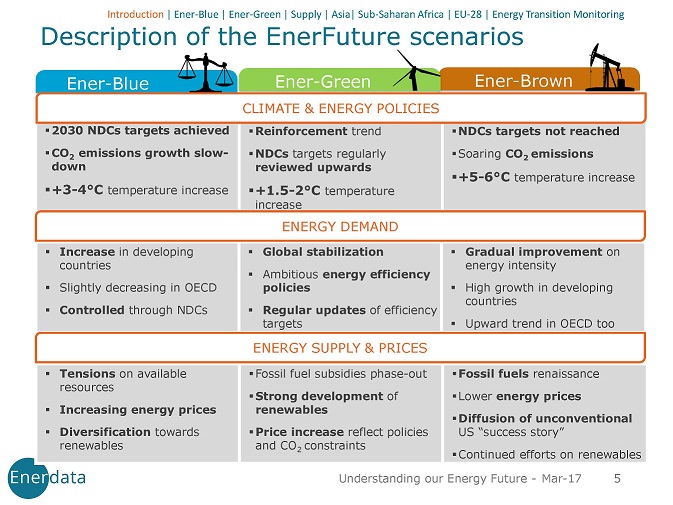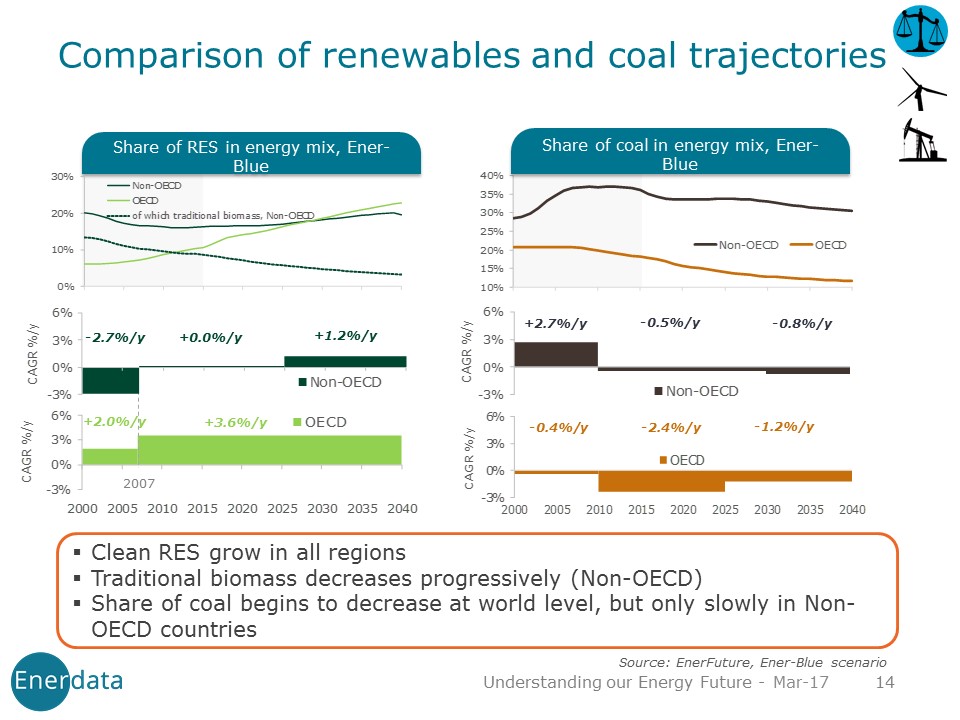Overview
The Enerdata Global Energy Forecasting team just released its latest 2040 world energy scenarios. Leveraging the POLES model, we offer expert foresight for strategic/business planning and policy making: analysis of energy demand, energy mix and penetration of renewables, evolutions and challenges according to climate constraints and technologies.
The publication provides a global energy overview, with a specific focus on Asia, Africa and Europe, and outcomes such as:
- 3/4 of the demand growth over 2015-2040 will come from Asia, and 15% from Africa (Ener-Blue Scenario, +3-4° temperature increase )
- One kWh of power generated will produce 75% less CO2 emission in 2040 vs 2015, (Ener-Green Scenario, +2° temperature increase )
- Universal electricity access in Africa by 2030 would require 7% of the global investments needs for the energy sector
- In the Ener-Blue scenario, the future energy mix remains dominated by fossil fuels, but NDCs planned policies regarding climate mitigation, energy efficiency and renewable energy sources lead to a diversification towards other sources of energy. However, the efforts defined in NDCs are not ambitious enough to limit the increase of the average global temperature to 2°C in 2100, but these efforts are compatible with a 3-4°C objective.
- Asia will account for 75% of the total primary consumption growth between 2015 and 2040 (Ener-Blue), followed by Africa (15%). In the meantime, energy intensity of non-OECD countries will converge to OECD level. In Asia, RES power capacities will reach 45% of the power mix by 2040. In Africa, reaching the universal electricity access target by 2030 would represent only 7% of the global investment needs for the energy sector ($1 trillion/yr).
- In the Ener-Green scenario, there is a clear transition from the current energy system towards a long-term decarbonisation, with substantial efforts on energy efficiency, initiatives to phase out fossil fuel subsidies and a real emergence of renewable energy technologies. RES and nuclear reach 70% of power capacities around 2040; there is a growing adaptation of cleaner coal technologies and a wide-scale of deployment of CCS. This new “green deal” leads to a reduction factor of 2 of world emissions by 2050.
- In the Ener-Brown scenario, oil and gas prices are expected to remain weak: prices slowly recover from present collapse, but remain well below the last decades’ highs. Confirmed energy commitments in some regions as well as technological innovation foster a significant development of low energy intensive processes and technologies. Renewables achieve a substantial deployment but affordable fossil fuels remain a competitive and attractive source of energy. Without a global agreement, non-coordinated policies result in soaring CO2 emissions across the world, towards +5-6°C temperature increase by the end of the century.


Conclusions
The paper will present detailed results related to the Ener-Blue scenario (NDCs, 3-4°C), its impacts on different energy sources and geographical regions, as well as its challenges in implementation. It will also show what additional commitments are needed to move from the Ener-Blue to the Ener-Green (2°C) scenario and some results for the Ener-Brown (5-6°C) scenario where fossil fuel resources are cheaper, larger and energy/climate policies are less ambitious.
Three regional focuses based on Enerfuture scenarios will present energy projection key figures for Asia, Africa and European Union.
 Energy and Climate Databases
Energy and Climate Databases Market Analysis
Market Analysis